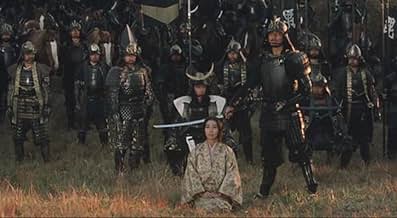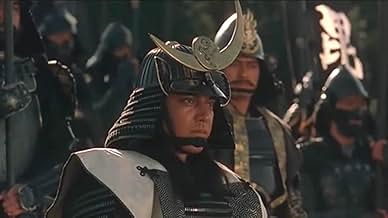IMDb-BEWERTUNG
6,8/10
1183
IHRE BEWERTUNG
Nach Jahren des Leids, nach Vergewaltigung und Folter, entkommt die junge Le Ly dem Inferno des Vietnam-Krieges. Doch auch fern ihrer Heimat scheint es keinen Frieden für sie zu geben…Nach Jahren des Leids, nach Vergewaltigung und Folter, entkommt die junge Le Ly dem Inferno des Vietnam-Krieges. Doch auch fern ihrer Heimat scheint es keinen Frieden für sie zu geben…Nach Jahren des Leids, nach Vergewaltigung und Folter, entkommt die junge Le Ly dem Inferno des Vietnam-Krieges. Doch auch fern ihrer Heimat scheint es keinen Frieden für sie zu geben…
- Auszeichnungen
- 1 Gewinn & 6 Nominierungen insgesamt
Stuart Whitman
- Narrator (English version)
- (Synchronisation)
Empfohlene Bewertungen
This is one of the prettier films I've seen with some wonderful cinematography and beautiful scenery. It's the reason I kept the film for quite a while, because the story was uninvolving. All the characters sound the same with a lot of the grunting macho male voices. The Japanese seem to show this in a number of films and is so foreign to our culture, it's hard to relate.
This is a story about two warriors - one shown in orange and the other in black, but it really wasn't good guy-versus-bad guy, just two people battling over land. Boy, that sounds familiar, as you know. Countries do the same, unfortunately.
This movie, according to critics, was supposed to have some fantastic action scenes. Well, let's just say that's not the case; the action scenes are very overrated.
Great visuals are the attraction here; not much else. Still, it's a shame something this beautiful is not available on DVD.
This is a story about two warriors - one shown in orange and the other in black, but it really wasn't good guy-versus-bad guy, just two people battling over land. Boy, that sounds familiar, as you know. Countries do the same, unfortunately.
This movie, according to critics, was supposed to have some fantastic action scenes. Well, let's just say that's not the case; the action scenes are very overrated.
Great visuals are the attraction here; not much else. Still, it's a shame something this beautiful is not available on DVD.
One of my favorites, despite all the historical inaccuracies. As a Canadian, I feel a certain pride watching it repeatedly.
Filmed in Alberta, Canada for its wide open space and abundance of horses. Morley Flats standing in for the Plains of Kawanakajima. 3,000 Canadian extras and 1,000 horses were used for the huge battles. During the filming, several behind-the-scenes TV documentaries were made and I was fortunate to video-tape most of them.
Alberta's superb riders, cowboys and cowgirls, and native Americans, 1,000 of them were employed to appear as mounted samurai. 2,000 other extras were transported by schoolbuses to the shooting location to appear as samurai infantry. Many were young kids, many were young girls, because they were the right height to fit into the thousands of samurai armor used for the film. These extras were trained in spear-fighting and drilled to march in unison.
To hide their Caucasian features, the 3,000 Canadian extras all wore armoured face guards. These technically made them all Samurai. One of the flaws in the film, since the bulk of actual samurai armies were composed of peasant soldiers (ashigaru), whose faces would have been exposed and unarmoured.
As a Canadian, I still get chills watching the spectacular battle scenes. Those Canadians made fine samurai.
Filmed in Alberta, Canada for its wide open space and abundance of horses. Morley Flats standing in for the Plains of Kawanakajima. 3,000 Canadian extras and 1,000 horses were used for the huge battles. During the filming, several behind-the-scenes TV documentaries were made and I was fortunate to video-tape most of them.
Alberta's superb riders, cowboys and cowgirls, and native Americans, 1,000 of them were employed to appear as mounted samurai. 2,000 other extras were transported by schoolbuses to the shooting location to appear as samurai infantry. Many were young kids, many were young girls, because they were the right height to fit into the thousands of samurai armor used for the film. These extras were trained in spear-fighting and drilled to march in unison.
To hide their Caucasian features, the 3,000 Canadian extras all wore armoured face guards. These technically made them all Samurai. One of the flaws in the film, since the bulk of actual samurai armies were composed of peasant soldiers (ashigaru), whose faces would have been exposed and unarmoured.
As a Canadian, I still get chills watching the spectacular battle scenes. Those Canadians made fine samurai.
This movie has been one that I've been searching for years. It has left that kind of impression on me. The story and historical value of this movie has allowed me to visualize a better understanding of those feudal times.
The only problem is that I'm still searching to obtain a copy. If you have any ideas where to look, it would be greatly appreciated.
The only problem is that I'm still searching to obtain a copy. If you have any ideas where to look, it would be greatly appreciated.
This movie has great battle scenes--large, intense and seemingly real. The clash between the red and black colored armies is a visual treat. The problem is that for as great as these scenes are, the film lags greatly on the personal level. The dialog just seems as if it is being filmed at a great emotional distance--and OFTEN, the scenes are actually filmed at a pretty great physical distance. If the movie could have been re-edited with new writing and direction for the non-spectacular scenes, it might achieve greatness. Otherwise, it just seems a little too cold and distant to become engaging. In this sense, it looks, at times, more like a documentary on the History Channel more than a film about PEOPLE and events.
I happened to get a chance to see Ten To Chi To or Heaven And Earth, as we knew it here, on the big screen when it debuted in Calgary in the spring of 1990. After having worked many long hours on the movie for a good part of the late summer in 1989 as one of the 2000 Samurai infantry extras, it was amazing to see the finished product on the big screen. As mentioned in one of the earlier reviews, for fans of the Samurai movie genre, this is a must see. The large battle scenes are spectacular.
Trivia note. Actor Ken Watanabe was originally cast as one of the lead actors in Heaven and Earth. While filming Ken was diagnosed with acute myelogenic leukemia, a life-threatening disease of the bone marrow, that put an end to his part in the movie. Ken had to return to Japan for treatment that kept him away acting for a few years. He came back in 1994 only to have a relapse, but once again battled back. Ken has been nominated for Best Actor in a supporting role at this year's Academy Awards for his outstanding performance as Katsumoto in The Last Samurai. I wish him all the best!
BTW, I was one of a handful of extras who worked all through the filming from July to early Sepetebmber 1989, here in Alberta. During the last few days of filming there was only about 50 or so of us left. On the final day, final scene, a Saturday afternoon IIRC, some production people came around and handed each of us a cold beer. Director Haruki Kadokawa came out and toasted us. He smiled and said, "Very long. Very hard. Thank you!"
Trivia note. Actor Ken Watanabe was originally cast as one of the lead actors in Heaven and Earth. While filming Ken was diagnosed with acute myelogenic leukemia, a life-threatening disease of the bone marrow, that put an end to his part in the movie. Ken had to return to Japan for treatment that kept him away acting for a few years. He came back in 1994 only to have a relapse, but once again battled back. Ken has been nominated for Best Actor in a supporting role at this year's Academy Awards for his outstanding performance as Katsumoto in The Last Samurai. I wish him all the best!
BTW, I was one of a handful of extras who worked all through the filming from July to early Sepetebmber 1989, here in Alberta. During the last few days of filming there was only about 50 or so of us left. On the final day, final scene, a Saturday afternoon IIRC, some production people came around and handed each of us a cold beer. Director Haruki Kadokawa came out and toasted us. He smiled and said, "Very long. Very hard. Thank you!"
Wusstest du schon
- WissenswertesSet a world record for the most number of saddled horses ever used in one sequence for a motion picture: 800 horses.
- PatzerThe Ashigaru (foot-soldiers) all wore Mempo (face masks). Mempo were only worn by samurai (and not even then by ALL samurai), who were all mounted. The reason for this is because pretty much all of the Ashigaru were played by Canadians, and the Mempo hid this fact.
- VerbindungenReferenced in Martial Law II: Undercover (1991)
Top-Auswahl
Melde dich zum Bewerten an und greife auf die Watchlist für personalisierte Empfehlungen zu.
- How long is Heaven and Earth?Powered by Alexa
Details
Box Office
- Budget
- 42.000.000 $ (geschätzt)
Zu dieser Seite beitragen
Bearbeitung vorschlagen oder fehlenden Inhalt hinzufügen

Oberste Lücke
By what name was Die letzte Schlacht der Samurai (1990) officially released in India in English?
Antwort























